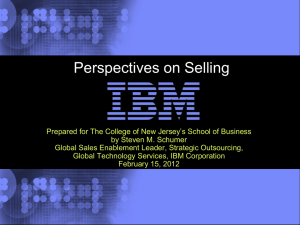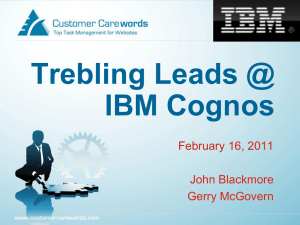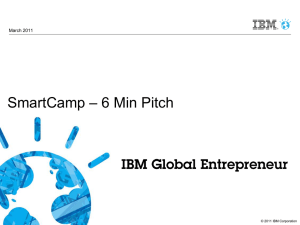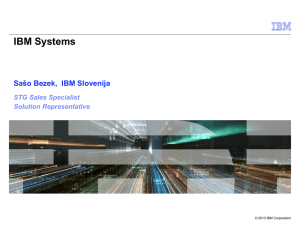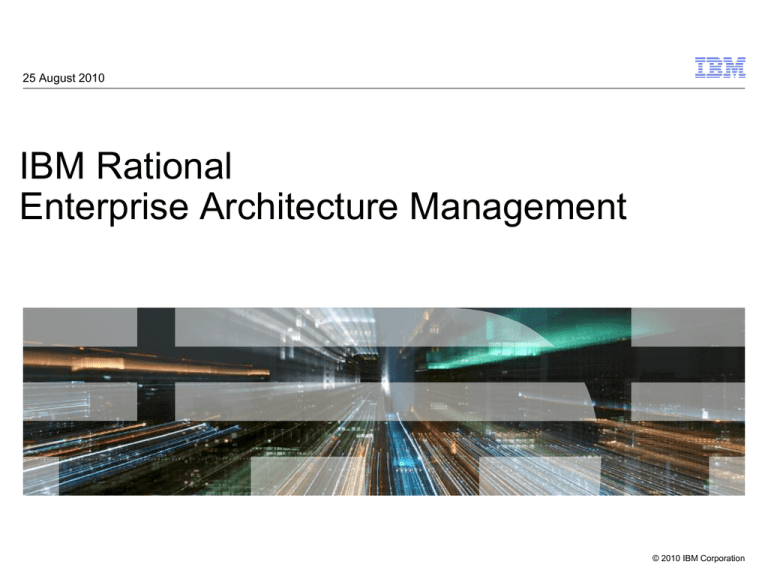
25 August 2010
IBM Rational
Enterprise Architecture Management
© 2010 IBM Corporation
IBM Rational Enterprise Architecture Workbench
The landscape facing business leaders means “we need to innovate with less”
Enable Innovation & Change
75
65
55
45
35
25
15
5
Average Lifetime
of S&P Top
Companies
Rising Cost
of Operations
Inability
to Innovate
Increased competitive
& economic pressures
to deliver differentiation
and move quickly
1928'38 '48 '58 ‘68 '78 '88 '98 '08 '18
2005 2006 2007 2008
2005
2006
2007
2008
What the business wants to do!
Lower Cost & Risk
Globalization and
regulatory oversight
driving improved
efficiencies, security &
compliance management
What the business must do!
Operational
& maintenance
costs continue to
grow
The cost of failed
projects & rework
compounds the
problem
Budgets are
shrinking
at a time when
investment is
needed in strategic
business assets
© 2010 IBM Corporation
IBM Rational Enterprise Architecture Workbench
…Forcing Companies to revisit how they manage their infrastructure
Virtualization
• Three client imperatives:
Energy
Efficiency
Information
Infrastructure
Service
Management
Business
Resiliency
• Seven primary initiatives:
Asset
Management
Security
Improve Service
Manage Risk
Reduce Cost
Service Management
Virtualization
Energy efficiency
Asset Management
Security
Business Resiliency
Information Infrastructure
© 2010 IBM Corporation
Customer Use Cases/ Pain Points
Capture Strategy (Business and IT)
Generate Capability Road Maps
Design New Capability
Manage Requirements
Model Business Processes / Activities
Manage Obsolescence
Model Alternate Future Architectures
Perform Impact Analysis
Business Continuity Management
Upgrade Planning
TCO Management (Plan, Prioritise & Authorise Spend)
Measure Performance
IT Portfolio Management
Enterprise Architecture & Solution Governance
Guiding Principles & Policies
Future Environment Blueprints
Standards Management
© 2010 IBM Corporation
Subjects and Components Of EA
© 2010 IBM Corporation
Using TOGAF™ As A Foundation To Deliver EA
© 2010 IBM Corporation
Where does Application Portfolio Management fit in?
Project
Portfolio
Project Portfolios are the proposed, and in-flight capabilities
that will drive new business value
Service portfolios are a consolidated view of the functional
and shared business capabilities that the organization uses
to operate
Application Portfolios captures and organizes information
about the application portfolio so that business and IT
executives can make prudent decisions around
investing/replacing/retiring applications
IT Portfolio management encompasses applications,
services & projects, and bring organizational, market &
product decisions into focus for strategic alignment
Service
Portfolio
Application
Portfolio
IT Portfolio
Enterprise architecture is a dynamic map of the
organization – Connecting business and IT in one view
Enterprise Architecture
© 2010 IBM Corporation
IBM Rational Enterprise Architecture Workbench
What is the Workbench?
Recently Rational has moved from point solutions to a workbench approach for our
customers – an integrated solution offering designed to support processes and governance
of the process.
A Workbench is a logical grouping of products that solves a business problem
The Workbench provides pre-installed accelerators to achieve results quicker
– TOGAF Modeling templates
– Project assessment artefacts
– Reports are, designed, implemented and documented
– Specified data migration, even at high levels of data can be accommodated
– Knowledge transfer assets are defined, designed, and implemented
– Set an expectation for number of users supported; at a realistic transaction loads
– Known infrastructure weak points, for performance, are defined and documented
– Ability to tailor solution sets
Deployment activities are defined, designed and documented
10
© 2010 IBM Corporation
Step 1. Build a holistic view
Strategy
Resources
& costs
Architect the
Enterprise
Opportunities
Business
Impact and Risk
Analysis
Link Business
& IT
Perspective
Cost-cutting
Information
Systems
Technology
Harvest
Enterprise
Information
Change /
Transformation
Implementation
Optimized Solution
/ IT Planning
Consolidation
Planning
Increased
Visibility
Business
& Technology
Impact
Architecture
Vision
Business and IT
Alignment
Business & IT
Architectures
Opportunities
& Solutions
Solutions
Planning
Solution
Implementation
& Governance
© 2010 IBM Corporation
Step 2. Balance current needs and long-term demand
Sustained Business Value
Execution
Roadmap
Goals
Objectives
Needs
Enhanced APM
Portfolio Management:
Financial Analysis and Optimization
Enterprise Architecture:
Enterprise Planning
Holistic business-IT views
Business and technology risk analysis
Business Intelligence
Dashboard
Services Portfolio
Enterprise
Decision Support
Application
and IT
Discovery
Analysis and
Optimization
Application Portfolio
© 2010 IBM Corporation
Step 3. Understand the business risk of change
Sustained Business Value
Goals
Objectives
Needs
Targeted Strategy
and Direction
Enhanced APM
Portfolio Management:
Financial Analysis and Optimization
Enterprise Architecture:
Holistic business-IT views
Business and technology risk analysis
Services Portfolio
Application
and IT
Discovery
Application Portfolio
IT Planning and
Transformation
© 2010 IBM Corporation
Step 4. Execute and govern your portfolio – new and existing
Develop roadmap – one view of business
and IT architectures, linked to business
decisions and clearly articulated as scope
Align execution activities to the
application strategy (future state)
– Reduce risk by quickly determining
the full impact of proposed changes
– Ensure application lifecycles do not
erode APM optimization
Measure, monitor, and control new
proposals and transformational activities
– Minimize impact on vision and value
of ad-hoc or non-collaborative
activities
Business Driven
Innovation
© 2010 IBM Corporation
Business Objectives
Strategy
As-Is Architecture
To-Be Architecture
Business Architecture
Business Architecture
Information Architecture
Information Architecture
Application Architecture
Application Architecture
Technology Architecture
Technology Architecture
Define and manage
Requirements through to
Delivery
Assess Opportunities and
Solution Alternatives
Project Portfolio Management
© 2010 IBM Corporation
Managing the business of IT: Workflow details
Harvest current
infrastructure from
CCMDB/TADDM
Executive Dashboards
Report on Portfolio,
project and process
Status
Build/Update Current
State Architecture
Analyze to Define
Future State of
Business
Practitioner / Project
feedback loops
IT Support
Define Strategy &
Vision
Capture Future State
in TOGAF 9
Define Key
Capabilities
Collect and Analyze
stakeholder / financial
priorities
Compare to Current
State, Perform Gap
Analysis
Define Transition
Initiatives
Analyze and prioritize
Initiatives
Project Planning
Architect & Design the
Prioritized Solutions
Define scope &
roadmap initiatives
Project Execution
Governance and
Review Board
Extended
Team
CEO Team
CIO & CTO,
LoB
Executives,
Enterprise
Architects
Steering Cmte,
IT & LoB
Executives,
PMO
Project and
Program
Managers
© 2010 IBM Corporation
Managing the business of IT: Workflow details
Tivoli
Insight / RPE / Cognos
Harvest current
infrastructure from
CCMDB/TADDM
Executive
Dashboards
Report on Portfolio,
project and process
Status
Build/Update Current
State Architecture
Analyze to Define
Future State of
Business
Practitioner / Project
feedback loops
IT Support
Define Strategy &
Vision
Governance and
Review Board
Extended
Team
CEO Team
System Architect
System Architect
Capture Future State
in TOGAF 9
Define Key
Capabilities
Compare to Current
State, Perform Gap
Analysis
Define Transition
Initiatives
Architect & Design the
Prioritized Solutions
CIO & CTO,
LoB
Executives,
Enterprise
Architects
Focal Point
Collect and Analyze
stakeholder / financial
priorities
Analyze and prioritize
Initiatives
Project Planning
Define scope &
roadmap initiatives
Project Execution
Steering Cmte,
IT & LoB
Executives,
PMO
Project and
Program
Managers
Rational Project Conductor with Integration to delivery
© 2010 IBM Corporation
Define strategy & vision: business motivation model
© 2010 IBM Corporation
Build Architecture and Business Architecture Current State
© 2010 IBM Corporation
Report on portfolio, project and process status
© 2010 IBM Corporation
Utilize Executive Dashboards
© 2010 IBM Corporation
Managing the business of IT: Workflow details
Tivoli
Insight / RPE / Cognos
Harvest current
infrastructure from
CCMDB/TADDM
Executive Dashboards
Report on Portfolio,
project and process
Status
Build/Update Current
State Architecture
Analyze to Define
Future State of
Business
Practitioner / Project
feedback loops
IT Support
Define Strategy &
Vision
Governance and
Review Board
Extended
Team
CEO Team
System Architect
System Architect
Capture Future State
in TOGAF 9
Define Key
Capabilities
Compare to Current
State, Perform Gap
Analysis
Define Transition
Initiatives
Architect & Design the
Prioritized Solutions
CIO & CTO,
LoB
Executives,
Enterprise
Architects
Focal Point
Collect and Analyze
stakeholder / financial
priorities
Analyze and prioritize
Initiatives
Project Planning
Define scope &
roadmap initiatives
Project Execution
Steering Cmte,
IT & LoB
Executives,
PMO
Project and
Program
Managers
Rational Project Conductor with Integration to delivery
© 2010 IBM Corporation
Define Future state
© 2010 IBM Corporation
Compare to current state, perform gap analysis
© 2010 IBM Corporation
Define transition initiatives
© 2010 IBM Corporation
Managing the business of IT: Workflow details
Tivoli
Insight / RPE / Cognos
Harvest current
infrastructure from
CCMDB/TADDM
Executive Dashboards
Report on Portfolio,
project and process
Status
Build/Update Current
State Architecture
Analyze to Define
Future State of
Business
Practitioner / Project
feedback loops
IT Support
Define Strategy &
Vision
Governance and
Review Board
Extended
Team
CEO Team
System Architect
System Architect
Capture Future State
in TOGAF 9
Define Key
Capabilities
Compare to Current
State, Perform Gap
Analysis
Define Transition
Initiatives
Architect & Design
the Prioritized
Solutions
CIO & CTO,
LoB
Executives,
Enterprise
Architects
Focal Point
Collect and Analyze
stakeholder /
financial priorities
Analyze and
prioritize Initiatives
Project Planning
Define scope &
roadmap initiatives
Project Execution
Steering Cmte,
IT & LoB
Executives,
PMO
Project and
Program
Managers
Rational Project Conductor with Integration to delivery
© 2010 IBM Corporation
Collect and analyze stakeholder & financial priorities
© 2010 IBM Corporation
Analyze and prioritize initiatives
© 2010 IBM Corporation
Architect & design prioritized solutions
© 2010 IBM Corporation
Managing the business of IT: Workflow details
Tivoli
Insight / RPE / Cognos
Harvest current
infrastructure from
CCMDB/TADDM
Executive Dashboards
Report on Portfolio,
project and process
Status
Build/Update Current
State Architecture
Analyze to Define
Future State of
Business
Practitioner / Project
feedback loops
IT Support
Define Strategy &
Vision
Governance and
Review Board
Extended
Team
CEO Team
System Architect
System Architect
Capture Future State
in TOGAF 9
Define Key
Capabilities
Compare to Current
State, Perform Gap
Analysis
Define Transition
Initiatives
Architect & Design the
Prioritized Solutions
CIO & CTO,
LoB
Executives,
Enterprise
Architects
Focal Point
Collect and Analyze
stakeholder / financial
priorities
Analyze and prioritize
Initiatives
Project Planning
Define scope &
roadmap initiatives
Project Execution
Steering Cmte,
IT & LoB
Executives,
PMO
Project and
Program
Managers
Rational Project Conductor with Integration to delivery
© 2010 IBM Corporation
Define scope & roadmap initiatives
© 2010 IBM Corporation
Plan projects for Integrated Execution and Feedback
© 2010 IBM Corporation
In Summary..…
–
–
–
–
Build a holistic view
Balance current needs and long-term demand
Understand the business risk of change
Execute and govern your portfolio
IT Planning and
Transformation
Significant efficiency gains through visibility in decision
making
Enterprise
Decision Support
Savings in the investment budget through better
management of transformational projects
Improvement in the operations budget by better aligning
applications with business demand
Increased
Visibility
Analysis and
Optimization
Business and IT
Alignment
Four steps to success…
Business Driven
Innovation
© 2010 IBM Corporation
35
© 2010 IBM Corporation
www.ibm.com/software/rational
© Copyright IBM Corporation 2010. All rights reserved. The information contained in these materials is provided for informational purposes only, and is provided AS IS without warranty of any kind,
express or implied. IBM shall not be responsible for any damages arising out of the use of, or otherwise related to, these materials. Nothing contained in these materials is intended to, nor shall have
the effect of, creating any warranties or representations from IBM or its suppliers or licensors, or altering the terms and conditions of the applicable license agreement governing the use of IBM
software. References in these materials to IBM products, programs, or services do not imply that they will be available in all countries in which IBM operates. Product release dates and/or capabilities
referenced in these materials may change at any time at IBM’s sole discretion based on market opportunities or other factors, and are not intended to be a commitment to future
product or feature availability in any way. IBM, the IBM logo, Rational, the Rational logo, Telelogic, the Telelogic logo, and other IBM products and services
are trademarks of the International Business Machines Corporation, in the United States, other countries or both. Other company, product,
or service names may be trademarks or service marks of others.
36
© 2010 IBM Corporation




